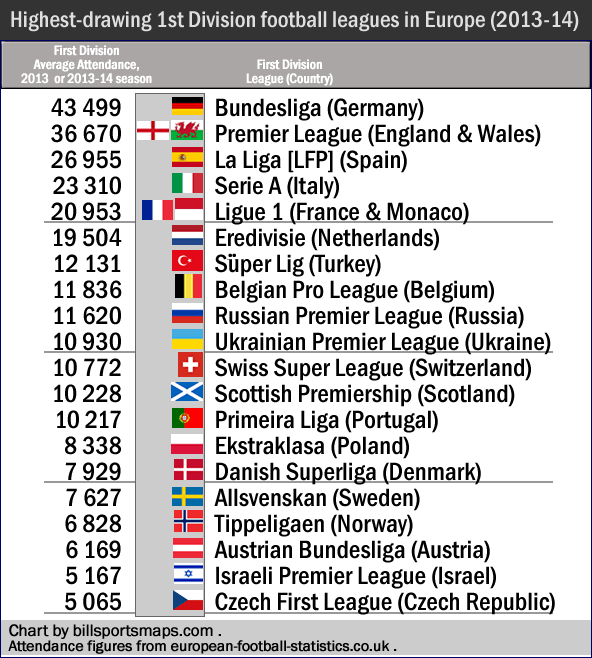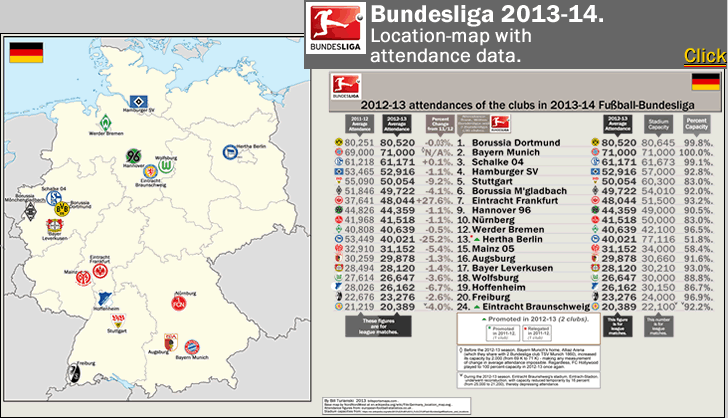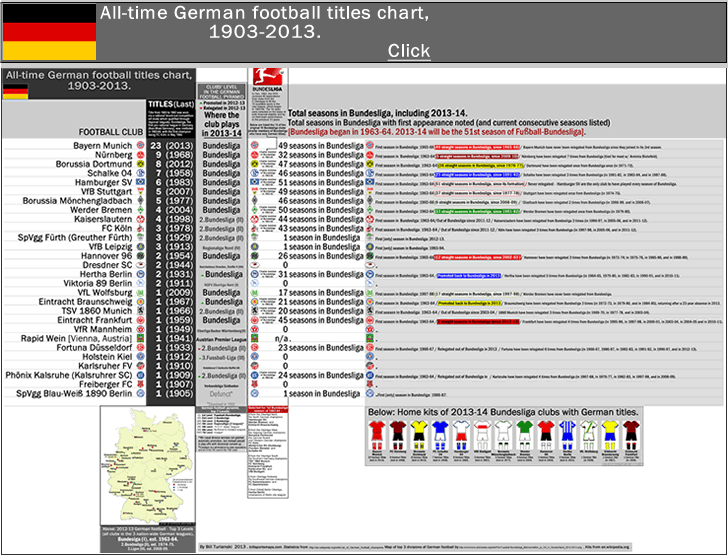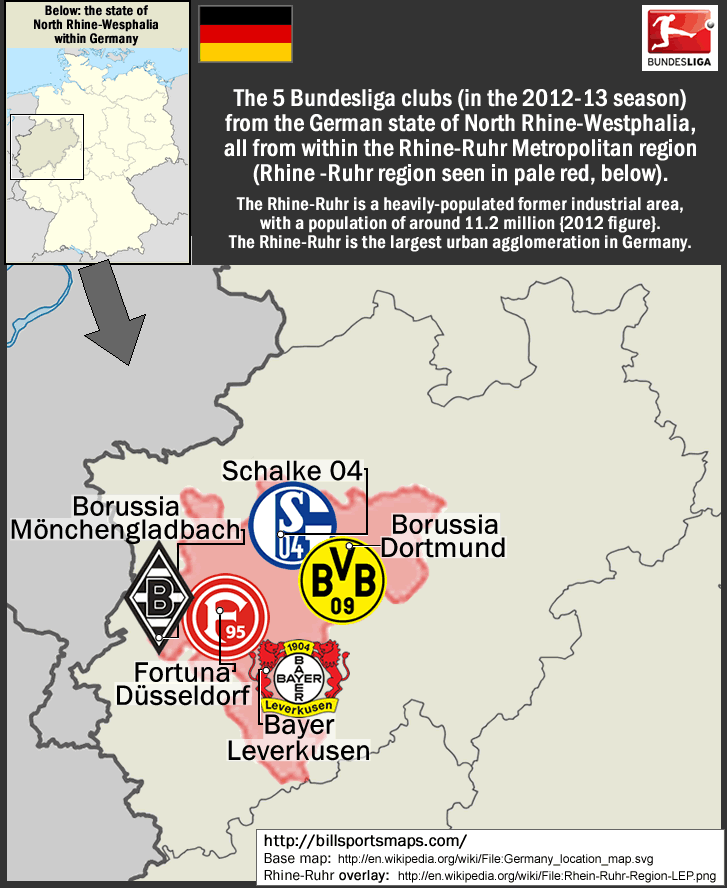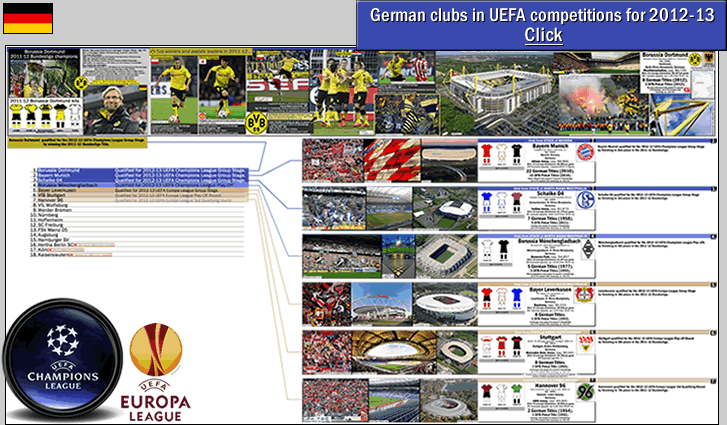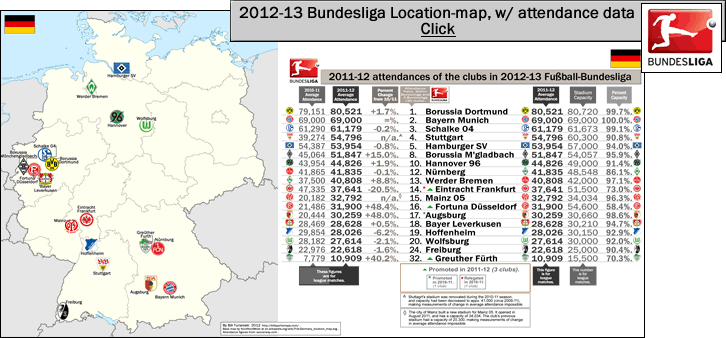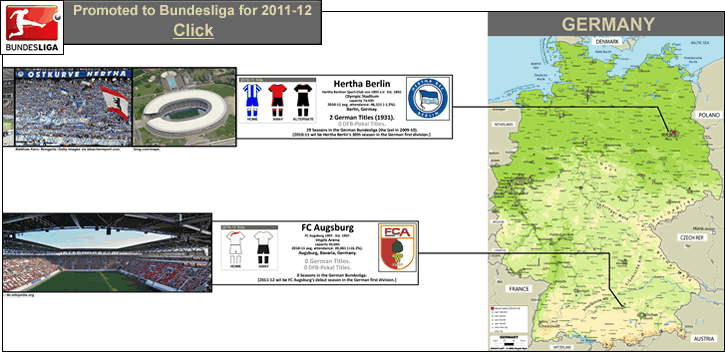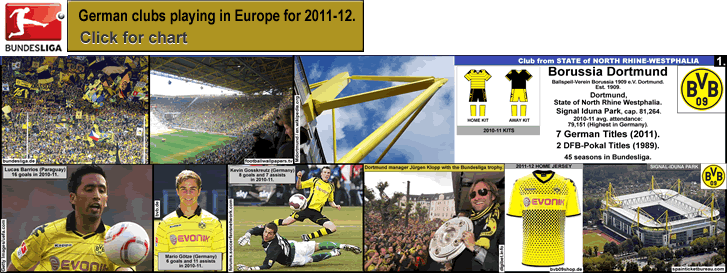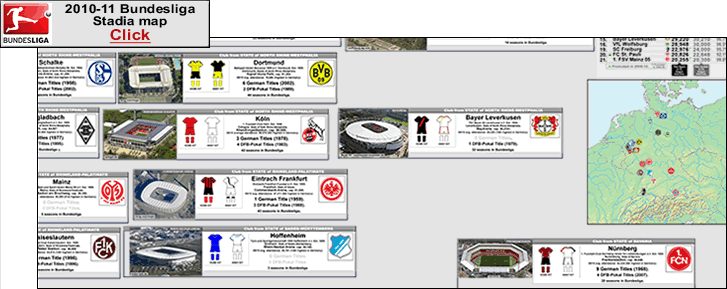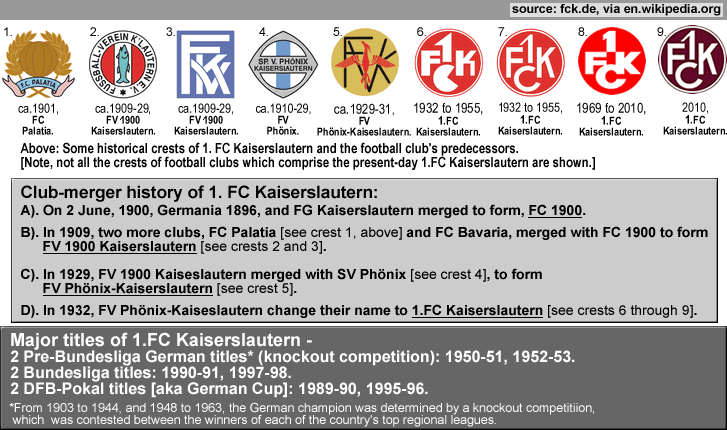The 3 promoted clubs to Bundesliga for 2012-13 – Greuther Fürth, Eintracht Frankfurt, Fortuna Düsseldorf…

The 3 promoted clubs to Bundesliga
…
…
Greuther Fürth makes it’s first division debut in the 2012-13 Bundesliga. Eintracht Frankfurt returns to the Bundesliga after a one-year absence. Fortuna Düsselldorf returns to the Bundesliga after a 15-year absence which included stints in the second, third, and fourth tiers of German football. All three of these clubs have won national titles in Germany, but none of them have won Bundesliga titles (Football-Bundesliga was established in 1963-64 – before that, the German national title each year was decided by a tournament comprised of regional champions and runners-up).
…
Greuther Fürth are from Fürth, which is a city in the Middle Franconian region of the northern part of Bavaria, just west of and adjacent to the city of Nuremburg. Modern-day sprawl has made the two municipalities contiguous (the city centers are only 7 km., or 4.3 miles, apart). The Nuremburg/Fürth/Erlangen metropolitan area is sometimes referred to as the Middle Franconian Conurbation, or the Nuremburg EMR [European Metropolitan Region]. The Nuremburg EMR has a population of around 3.51 million {2006 figure}. Fürth’s population is around 116,000 {2011 figure}. Fürth was once a major beer brewing center in Germany (around the turn of the 20th century, it had a bigger brewing industry than even Münich). Now Fürth is known for it’s toy-making industry (small-scale craft toys to large-scale industrial enterprises) and for being a center of solar technology – on sunny days, the local utility Infra Fürth puts 2 megawatts (2,000,000 Watts) of energy into the grid per day.
Below: Greuther Fürth are known as Die Kleeblätter, which translates as the Cloverleaves. The 2012-13 season is Greuther Fürth’s Centenary, and the club is wearing metallic gold colored three-leaf-clovers as the badge on their usual green-and-white-hooped jerseys. The city of Fürth has used the trefoil, or three-leaf-clover, as their city seal since the 16th century.

Photo and image credits above – Small photo of 2012-13 Centenary crest on home kit badge from lms-ticket.de/greutherfuerth-shop. 1905 photo from de.wikipedia.org page on ‘Greuther Fürth‘. 1818 seal from ngw.nl. Present-day seal from ‘Fürth‘ (en.wikipedia). Municipality of Fürth official website banner from fuerth.de.
The club now known as Greuther Fürth started out in 1903 as the football branch of the gymnastics club 1860 Fürth. Three years later in 1906, the football branch – Spielvereinigung Fürth, or SpVgg Fürth – went independent of the gymnastics club. [Note: Spielvereinigung, often abbreviated to SpVgg, means 'playing club', and refers to sports that are played not by individuals, but by teams.]. The club grew, and by 1914, SpVgg Fürth had over 3,000 members, making it the largest German sports club at the time. 1914 was also the year Fürth won their first national title, under English coach William Townley, defeating VfB Leipzig 1-0 in Magdeburg in the 154th minute of play (there were 64 minutes of extra time added on before the golden goal was scored). In October, 1915, German football championship play was suspended, due to World War I, and 5 seasons ended up being lost. The German football championship competition was re-started in 1920, and Fürth picked up where they left off, as one of the dominant teams of the era. So in 1920, Fürth found themselves back in the final, versus none other than local rival 1. FC Nuremburg. But Nuremburg were in the midst of an 104-game unbeaten streak, and beat Fürth 2-0 in Frankfurt. These two clubs were so dominant during this time-period that in 1924, the national team was made up of players exclusively from SpVgg Fürth and FC Nuremburg. The 2 sets of players slept in separate rail cars, which was indicative of the fierce rivalry between the two clubs. In 1926, Fürth won their second German title, beating Hertha Berlin 2-0 in Frankfurt. Fürth’s third and last German title was won 3 years later, in 1929, again at the expense of Hertha Berlin, and in a stadium just a few kilometers from their home-base, with Fürth winning 3-2 in front of 50,000 in Club-Stadion im Zabo in Nuremburg.
German football was re-organized in 1933 under the Third Reich into the Gauliga (1933-45). The national championship was still decided by a knockout tournament, but there were now 16 districts {see this, ‘Gauliga/ Overview [with map]‘ (en.wikipedia.org)}. SpVgg Fürth began playing in the Gauliga Bayern. But Fürth’s moment had passed and the squads that replaced the championship-winning squads of the 1920s were only able to win one Gauliga Bayern title (in 1934-35), and never progressed to another national championship final.
After the fall of the Third Reich, with Allied occupation in the south, center, and west of the Teutonic lands, and Soviet occupation in the east, postwar German football comprised West Germany’s 5 Oberligen, and East Germany’s separate system {see this, ‘Oberliga Süd/ Overview [with map]‘ (en.wikipedia.org). Fürth began playing in Oberliga Süd, where they struggled, and 3 seasons in, in 1947-48, they were relegated to Landesliga Bayern [a present-day 3rd division league]. Fürth returned to Oberliga Süd the next season, and in 1949-50 as a newly-promoted-side, Fürth won the 1950 Oberliga Süd title. That season Fürth made it as far as the semifinals in the 1950 national playoffs, losing 4-1 to VfB Stuttgart. Four years later, two Fürth players, Karl Mai and Herbert Erhardt, were members of the 1954 German national football team that upset Hungary in Bern, Swirzerland to win the 1954 FIFA World Cup title.
With the long-overdue creation of a national football league in Germany in 1963-64 [official name: Fußball-Bundesliga], Fürth did not qualify as one of the then-sixteen teams that made up the new national first division. So they found themselves playing second division football in the Regionalliga Süd, where they were generally a mid-table side whose best finish was in third place in 1967. A national second division – 2.Bundesliga – was formed in 1974, with SpVgg Fürth as one of it’s charter members. One decade later, SpVgg Fürth were relegated to the regional 3rd division, then slipped again, to the fourth division, in 1987. They returned to the 3rd division in 1991, and after national lower divisional re-organization in 1994, Fürth became part of the thrd incarnation of Regionalliga Süd.
Meanwhile, a small village team from the western end of the city of Fürth was moving up the ladder. TSV Vestenbergsgreuth, established 1974, began as a 4th division club. In 1987, TSV Vestenbergsgreuth won promotion to the 3rd division just as SpVgg Fürth were being relegated to the 4th division. By the mid 1990s, both clubs were playing at about the same level in the 3rd division. For financial considerations, and for a chance to become a bigger and more successfil club, a merger seemed logical, and so in 1996, SpVgg Greuther Fürth was created, the ‘Greuther’ in the new name reflecting the TSV Vestenbergsgreuth heritage. The re-constituted club’s new crest included the wooden shoe from the Vestenbergsgreuth crest to indicate that the new club was more than just a continuation of SpVgg Fürth. The new club won promotion to 2.Bundesliga in it’s first season as Greuther Fürth (in 1996-97), finishing in 2nd in the division, right behind long-term-rival FC Nuremberg. Then, for a decade and a half, Greuther Fürth became a mainstay in the top half of the table in the German second division (with the exception of 2009-10, when they finished in 11th place). In December, 2009, former Fortuna Düsseldorf and FC Schalke MF Mike Büskens took over as manager of Greuther Fürth. In the season after that, in 2010-11, Greuther Fürth finished in 4th place in 2.Bundesliga, missing out at a shot at the Bundesliga promotion/relegation playoff finals by 4 points. By this point in time, Greuther Fürth was the longest-serving member of the German 2nd division. So it was a natural progression, after 15 seasons, for Fürth to finally get promoted in 2012-13. Quebec, Canada-born Olivier Occéan powered Fürth to the 2. Bundesliga title on the strength of his league best 17 goals (in 30 appearances, with 9 assists). But in July 2012, Occéan was sold to another newly promoted (and much bigger) club, Eintracht Frankfurt. Also important to Fürth’s successful promotion-campaign last season was FW Chrisopher Nöthe, who netted 13 league goals (in 26 appearances). Nöthe returns for the 2012-13 season. Other crucial members of the promotion-winning-squad last season (all of whom have returned for 2012-13) – 26-year-old captain, Defender Mërgim Mavraj, an Albania international; Kazhakstan-born/ethnic German Midfielder Heinrich Schmidtgal; the Münich, Bavaria-born former Bayern Munich youth team player, Midfielder Stephan Fürstner; and last but not least, the Winger Gerald Asamoah, who played 279 times for Schalke, and who came over from FC St. Pauli in the January 2012 transfer window, and scored 5 goals in 10 games for Fürth last spring.
Greuther Fürth are a pretty small club for Bundesliga standards – the Trolli Arena only had a capacity of around 15,000, and over the summer that capacity has been increased by 3,000 or so to a 18,500 capacity. Greuther Fürth averaged 10,909 last season, while the average attendance in the Bundesliga last season was 45,116. It remains to be seen whether Fürth will be able to survive in the German top flight as a club drawing less than 25,000, as other similar sized Bundesliga clubs like SC Freiburg are, and like FSV Mainz were. Freiburg still play in a small stadium (24,000 capacity), but Mainz built the 34,000-capacity Coface Arena in 2011, a move that has helped their chances of survival in Bundesliga immensely. Starting with their first division debut in 2004-05, Mainz have played 7 seasons in Bundesliga in 2 different spells, and won promotion both times with present-day Dortmund manager Jürgen Klopp. Mainz drew around 20K per game in their last 2 seasons at their old arena, and drew 32,792 last season at the Coface Arena, when they finished in 10th place, after a 13th-place finish in 2010-11. Coface Arena, which was built by and is owned b, FSV Mainz, is not a bowl stadium, as too many large modern football stadiums are, and it’s designers looked to the high stands of traditional English football grounds as inspiration. Just think what amount of security that extra twelve-thousand tickets sold per home game means to Mainz. Freiburg had the lowest attendance in Bundesliga last season at 22,618 per game, and still managed to stay safe of the drop-zone (Freiburg finished in 11th place in 2012-13). But Freiburg have had 2 relegations and 2 promotions since 2002 and their total number of seasons spent in Bundesliga is 13 seasons – in other words, Freiburg are a club that could be on the verge of becoming a yo-yo club. It would seem that having attendances in the 18k to 24K range would significantly contribute to making a club’s long-term Bundesliga status unsustainable.
Here is a preview of Greuther Fürth’s 2012-13 Bundesliga team, from bundesligafanatic.com, from 17 August 2012, by Rick Joshua, ‘Season Preview – SpVgg Greuther Fürth – Bundesliga Bow for Die Kleeblätter‘.
…
Eintracht Frankfurt are from Frankfurt, in the state of Hesse. Their colors are red and black and they are known as die Adler (the Eagles), after the city of Frankfurt’s city seal, the one-headed imperial eagle, which dates back to the 13th century {see this (en.wikipedia.org/Eintracht Frankfurt/Colours, crest and nicknames); }. The word Eintracht translates as ‘unity’.
The official name for the city of Frankfurt is Frankfurt am Main, which means Frankfurt on the [River] Main. Frankfurt is Germany’s 5th largest city, with a city population of 679,000 {2010 figures}. Frankfurt is part of the second-largest metropolitan region in Germany, Frankfurt Rhine-Main, which has a population of around 5.8 million. Frankfurt is a world center for finance. The Frankfurt Stock Exchange is the world’s 12th-largest stock exchange by market capitalization. Frankfurt is really expensive to live in – it is the 10th-most expensive city to live in in the world, according to The Economist, ‘Worlds Most Expensive Places To Live Is,,,[Zurich]‘.
In 1911, the club now known as Eintracht Frankfurt was the result of the merger of two different Frankfurt-based clubs (both of which formed in 1899 – Frankfurter Fußball-Club Viktoria von 1899 and Frankfurter Fußball-Club Kickers von 1899). These two clubs merged in May 1911 to become Frankfurter Fußball Verein (Kickers-Viktoria), better known as Frankfurter FV. The merger was an instantaneous success, with Frankfurter FV winning the 1912, the 1913, and the 1914 Nordkreis-Liga titles (the Nordkreis-Liga was the top football league of Hesse-Nassau and the Grand Duchy of Hesse, from 1908 to 1918). In 1920, Frankfurter FV joined the gymnastics club Frankfurter Turngemeinde von 1861 to form TuS Eintracht Frankfurt von 1861. But 7 years later, in 1927, the two went their separate ways, and the football-club-branch became known as Sportgemeinde Eintracht Frankfurt (FFV) von 1899. SGE Frankfurt won some regional trophies in the late 1920s and early 1930s, and the club competed for the first time deeper into the national knockout championships, making it to the quarterfinals in 1930 and 1931, then making it to the final in 1932. In the 1932 German national championship final, (at the present-day Frankenstadion) in Nuremburg, Eintracht Frankfurt lost to Bayern Munich 2-0. This was the first of Bayern Munich’s record 21 German titles.
Following the 1933 Nazi take-over in Germany and the re-organization of football leagues into the 16 Gauligen, Frankfurt played first division football in the Gauliga Südwest/Mainhessen, consistently finishing in the upper half of the table and winning their division in 1938, but never getting to the latter stages of the national championship tournament.
Following World War II, Frankfurt was placed in the Oberliga Süd (1945–63). Their first 7 years they never challenged for a title, then they won the 1953 Oberliga Süd title. The Eintracht squad of this time-period featured Frankfurt-born MF Alfred Pfaff, who joined the team in 1949 after being on the club’s youth team. {Here is a color photo of Pfaff that shows the striking white jersey with red-collar-and-placket that Eintracht Frankfurt wore in the 1950s (pcsd.forumfree.it)}. Pfaff would play 12 seasons for Eintracht Frankfurt, with 301 appearances and 103 goals. Pfaff would also get 7 German caps and go on to be a member of the German national team that pulled off their shock World Cup victory in Switzerland in 1954. 5 years later, in 1958-59, with Alfred Pfaff as captain and playmaker, Eintracht Frankfurt won the Oberiga-Süd for the second time, then went all the way to the national tournament final, where, as fate would have it, they played their local rivals, Kickers Offenbach. [Kickers Offenbach are a club located just east of Frankfurt in Offenback am Main, and are currently a 3rd division club with 7 seasons played in Bundesliga (last in 1983-84), with one major title, the 1970 DFB-Pokal title.]. In the 1959 German national championship final group rounds, Eintracht had won all 6 matches in the first stage, which was an 8-team/2-group/6-matches-per-team-round-robin set-up (with group winners advancing to the final). The final was played in front of 75,000 in Olympiastadion in Berlin. It was a classic. In the first minute, Hungarian FW István Sztáni netted for Eintracht Frankfurt. Kickers Offenbach responded in the 8th minute, with FW Berti Kraus scoring. Eintracht FW Eckehard Feigenspan put Frankfurt back ahead in the 14th minute, but then MF Helmut Preisendörfer evened the score again in the 23rd minute. It stayed knotted at 2-2 straight to the 90th minute, and extra time was needed [the format: 30 minutes added extra time, with no golden goal; then a re-play if necessary]. In AET, Eckehard Feigenspan converted a penalty in the 93rd minute to make it 3-2 Eintracht. Then it was 4-2 for Eintracht in the 108th minute when István Sztáni scored again, for a brace. Kickers, though, weren’t down yet, and made it 4-3 through a goal by FW Siegfried Gast in the 110th minute. But in the 119th minute, Eckehard Feigenspan scored again for the hat trick, sealing it for die Adler (the Eagles), 5-3. In the photo below, Alfred Pfaff is seen at center raising the trophy during the post-match celebrations there in Berlin.
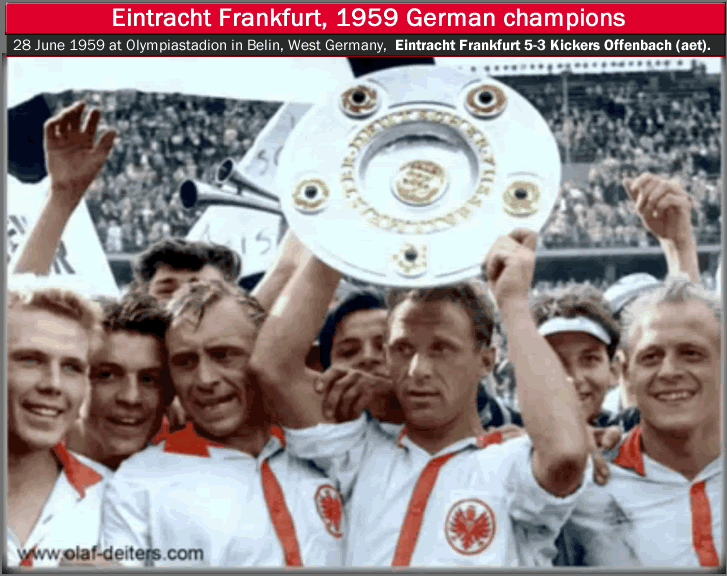
Image credit above -Image from youtube.com video uploaded by darkgeek2011, ‘Deutscher Meister 1959 – Eintracht Frankfurt – HD – 2012.wmv [1:13 video]‘. Image above is from a black and white photo {from: fnp.de}, which was color-tinted by Olaf Dieters, at http://olaf-deiters.com/.
In the 1959-60 European Cup competition – the 5th season of the tournament that is now called the UEFA Champions League – Eintraccht Frankfurt recieved a de-facto bye in the preliminary round when KuPS (of Finland) withdrew. In late November 1959, in the 1st Round, Eintracht drew the Swiss club Young Boys, and won 4-1 in the 1st leg at the Wankdorf in Bern, Switzerland in front of 35,000. The 2nd leg was at Eintracht’s then-55,000-capacity Waldstadion (now called Commerzbank Arena with a 51.5K capacity). The crowd of around 40,000 saw Eintracht play it safe with their 3-goal lead and draw 1-1 to advance. The Quartefinals in March 1960 had Eintracht matched up with the (now-third-division) Austrian club Wiener Sportclub. Ist leg went 2-1 to Eintracht in Frankfurt, again in front of around 40K. The 2nd leg, in front of 50,000 in Vienna’s Praterstadion [now called Ernst-Happel-Stadion)] saw Wiener Sportclub even the aggregate score, with a goal in the 31st minute. Then Eintracht Frankfurt’s FW Erwin Stein secured the aggregate-winning goal in the 59th minute.
That put Eintracht Frankfurt into the Semifinals in April 1960, where they were matched up against Glasgow Rangers. [The other European Cup Semifinalists in April 1960 were Real Madrid and FC Barcelona, and Real Madrid won that aggregate by the score of 6-2, with Alfredo Di Stéfano scoring twice, Ferenc Puskás scoring three times, and Francisco Gento scoring once for the all-whites].
On 13 April 1960, Eintracht destroyed Rangers 6-1 in the 1st leg, in front of an overflow crowd of 70,000 in Frankfurt. For the first half the match however, it was a tight affair, with Dieter Stinka of Frankfurt scoring in the 29th, closely followed by Eric Cadlow’s penalty conversion 2 minutes later for Rangers. But in the second half, the midfield wizard Alfred Pfaff took over, and scored a brace in five minutes, netting in the 51st and the 55th minutes. Then Dieter Lindner scored twice in 12 minutes (73′, 84′), and Erwin Stein added Frankfurt’s 6th goal in the 86th minute. The 2nd leg, on 5 May 1960 at Ibrox in Glasgow before 70,000, saw Eintracht Frankfurt score 6 again, for a 6-1 win and a final aggregate score of 12-4. Here were the goals…Rangers – John McMillan 10′, 54′; David Wilson 74′. Frankfurt – Eric Lindner 6′; Alfred Pfaff 20′, 88′; Richard Kreß 28′; Erich Meier 58′, 71′.
So on 18 May 1960, it was Real Madrid versus Eintracht Frankfurt in the 1960 European Cup final. Eintracht again traveled to Glasgow – this time to the Scottish national football stadium Hampden Park (current capacity of around 52,000). A vast overflow crowd of 126,671 watched the match. {Here is the match-day programme for the 1960 European Cup. Check out what the official match-day programme of the 1960 European Cup Final describes the match as… it reads [on the bottom of the cover of the programme], ‘EINTRACHT, Frankfurt v. REAL MADRID’. So even the folks who put the programme together thought Frankfurt were over-matched, seeing as how they didn’t use all-caps for the German club’s name like they did for the Spanish giants. The strange employment of the comma between Eintracht and Frankfurt is pretty interesting too.}.
From youtube.com uploaded by Canal de Fútbol Retro Os Clássicos.com, ‘Real Madrid 7–3 Eintracht Frankfurt (1959–60 European Cup [a 6:01 video of 1960 BBC newsreel]. Alfred Di Stéfano scored a hat trick for Real Madrid, and the all-time greatest Hungarian footballer, Ferenc Puskás, scored 4 goals. Eintracht started brightly, though, with Richard Kress scoring in the 18th minute. But then the Argentine-born Di Stéfano swiftly netted 2 goals in 3 minutes (27′, 30′), and Puskás made it 3-1 at 45′+1. Puskás then scored in the 56th, the 60th, and the 71st minutes. Erwin Stein got one back for Frankfurt with a goal in the 72nd minute, but Di Sréfano answered back a minute later. Erwin Stein then scored 2 minutes after that, and the score stayed at 7-3, and Real Madrid had won their 5th straight European title.
Who knows if that defeat injured some deep part of the collective psyche of Eintracht Frankfurt. The fact remains that Eintracht Frankfurt have never won another national title, and have, for such a relatively large club, only managed essentially to become a Cup-specialist club that’s last major title was won a quarter of a century ago. Which is the main reason that one of Eintracht Frankfurt’s nicknames is die Launische Diva, which translates as the moody diva.
2012-13 will be Eintracht Frankfurt’s 44th season in Bundesliga…
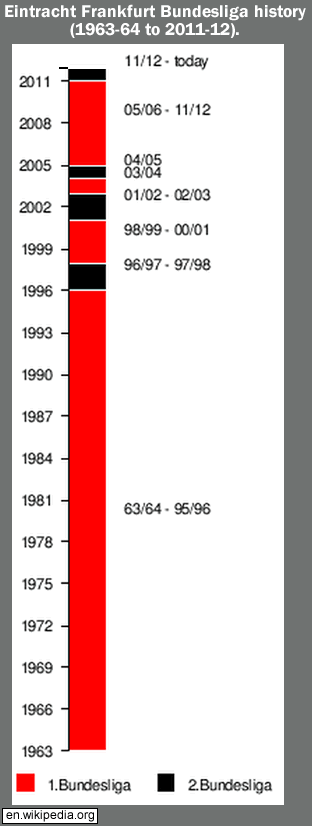
Image credit above – Eintracht Frankfurt/Founding member of the Bundesliga {en.wikipedia.org).
After the disappointment of their loss in the 1960 European Cup final, Eintracht Frankfurt remained a solid team for several years. The side earned themselves a place as one of the original 16 teams selected to play in the inaugural season of Bundesliga, in 1963-64. Eintracht initially played Bundesliga football for 35 seasons straight, finishing in the top half of the table more often than not. But the closest the Eagles have come to a second German title were the 5 times they ended up with 3rd place finishes, and the nearest they got to putting their hands back on the ‘Salad Bowl‘ was in 1991-92, when they finished in 3rd place, only two points back of champion VfB Stuttgart (Borussia Dortmund finished in second place that season).
Eintracht Frankfurt have won 4 DFB-Pokal titles – in 1974 by a score of 3-1 (aet) over Hamburger SV in front of 52,000 in Düsseldorf; in 1975 [defending their title] by a score of 1-0 over Duisburg in front of 43,000 in Hannover; in 1981 by a score of 3-1 over Kaiseslautern in front of 70,000 in Stuttgart; and in 1988 by a score of 1-0 over Bochum in front of 76,000 in West Berlin. Eintracht Frankfurt have been relegated 4 times to 2.Bundesliga. Their last relegation, in 2011-12, saw the Eagles rebound immediately. Their promotion campaigh was helmed by former Stuttgart, Wolfsburg, and Hamburger SV manager Armin Veh, who took over at Frankfurt on 30 May 2011. Last season Frankfurt drew 37,641 per game, which was highest in the second division; and in their last season in Bundesliga, in 2010-11, Frankfurrt drew 47,335. That was good enough for the 6th-highest average attendance 2 years ago. The 6th best attendance in the country and no titles in 25 years…sounds like a slightly-higher-drawing version of Aston Villa to me.
Here is Bundesliga Fanatic.com’s post on Eintracht Frankfurt’s 2012-13 team, from 22 August 2012, by Niklas Wildhagen, ‘Season preview – Eintracht Frankfurt – The Eagles have landed‘.
…
Fortuna Düsseldorf are from Düsseldorf, North Rhine-Westphalia. Düsseldorf’s city population is around 588,000 {2010 figure}, which puts the city as the 7th-largest in Germany. Düsseldorf is part of the largest metro area in Germany, the Rhine- Ruhr. The Rhine-Ruhr metropolitan region has a population of around 11.31 million {2011 figure}. Düsseldorf is basically is in the cente of the region (geographically and politically).
The Rhine-Ruhr is a metropolitan region which was once the industrial center of Germany for over one hundred years, starting at the dawn of the Industrial Revolution in the late 19th century, to the late post-War period of the 20th century. The Rhine-Ruhr is named after the Rhine and Ruhr rivers, on whose banks there grew so much of the heavy industry that initially forged Germany’s industrial might. There are usually 5 or 6 clubs each season in the Bundesliga that are from the Rhine-Ruhr metro region. For 2012-13, with Köln having been relegated out and Fortuna Düsseldorf having been promoted in, there will again be 5 clubs in Bundesliga which are from the Rhine-Ruhr – Bayer Leverkusen, FC Schalke 04, Borussia Dortmund, Borussia Möenchengladbach, and Fortuna Düsseldorf. You can see a map I made of these 5 clubs’ locations within the Rhine-Ruhr region {here}.
Before the Industrial Revolution, dating back to the Middle Ages, Cologne, Dortmund and other cities in the region were important trading cities, but by the 19th century the city of Düsseldorf grew to become the administrative center of the region and since 1945, it’s political capital. Today, the Rhine-Ruhr metro region accounts for around 15% of the GDP of the German economy, which would place it as the 3rd largest GRP (Gross Rating Point) of metropolitan areas in the European Union and the 16th largest GDP in the world. The problem is, the Rhine-Ruhr presents no unified image to the outside world – neither as a sort of mega-city or as a region – and the cities and sub-regions that make up the Rhine-Ruhr Metropolitan Area often end up competing with each other through separate economic policies.
The roots of Fortuna Düsseldorer Turn-und Sportverein Fortuna 1895 are in the former working class neighborhood in the eastern part of Düsseldorf, called Flingern, and now called Düsseldorf-Flingern. That is where Gymnastics club Turnverein Flingern was formed, on 5 May 1895. This club never fielded a football team. On 5 November 1919, TV Flingern merged with Düsseldorfer Fußball-Club Fortuna 1911 to form Düsseldorfer Turn-und Sportverein Fortuna. Let’s back-track 6 years to see where Düsseldorfer F-C Fortuna 1911, better known as Fortuna 1911, first entered league play…In 1913, Fortuna 1911 had began play in the 3rd division of the Westdeutsche Fußballmeisterschaft (West German football championship). [ 'Western German football championship', {excerpt from it's en.wikipedia page}...'The Western German football championship was the highest association football competition in Western Germany, in the Prussian Province of Westphalia, the Rhine Province, the northern parts of the province of Hesse-Nassau as well as the Principality of Lippe... The competition was disbanded in [the late summer of] 1933 with the rise of the Nazis to power.’…{end of excerpt} .].
In 1922, Fortuna Düsseldorf made it to the the first division in the Gauliga Berg Mark, and remained there until the German football league re-organization in 1933. In 1924, MF Ernst Albrecht began playing for Fortuna Düsseldorf. Albrecht would play two decades for the club (up until 1944), and was a German international.
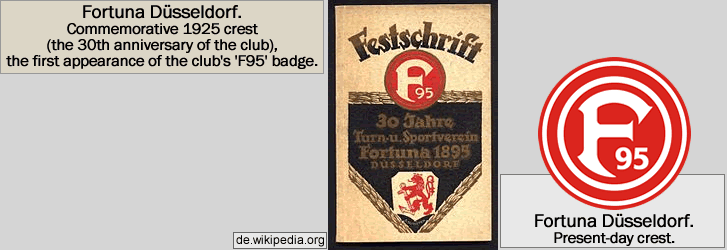
Image credit above – 1925 Fortuna Dussweldorf crest uploaded by Fortuna Family at de.wikipedia.org.
In 1927, Fortuna won its first honours as a first tier side: they captured a district level Bezirksliga title. Three more district league titles followed, and in 1931 Fotuna Düsseldorf won the Western German football championship, defeating VfB Bielefeld. But their German national football championship tournament run ended with a second-round defeat to Eintracht Frankfurt. Two years later, though, in 1933, Fortuna Düsseldorf, as runners-up in their league, qualified for the national tournament. That year, Fortuna went all the way in the 16-team-knockout tournament to the final, where they would face FC Schalke 04. It was the first appearance in the German final for both clubs, and it was a re-match of the 1933 Western German football championship final played earlier that spring, which Schalke had won 1-0.
In the 1933 German national football championship tournament, Düsseldorf had steamrolled through the early rounds, not conceding a goal. First they beat Vorwärts RaSpo Gleiwitz 9-0 in Düsseldorf in the 1st Round. Then Fortuna beat SV Arminia Hannover 3-0 in Hannover in the Quarterfinals. Then Fortuna beat Eintracht Frankfurt 4-0 in Berlin in the Semifinals. In the 1933 German national championship final, on 11 June 1933 in front of 60,000 at the Müngersdorfer Stadium in Cologne, over 20,000 Düsseldorf supporters made the short trip south to Cologne to cheer on their team. Düsseldorf started off strong, and in the 10th minute, FW Felix Zwolanowski scored for Düsseldorf. Schalke never got into their rhythm, but the match was still a tense affair for the Fortuna faithful until MF Paul Mehl made it 2-0 in the 70th minute. And then MF Georg Hochgesang scored in the 85th minute to make it 3-0 and seal the first (and the only) national title for Fortuna Düsseldorf.
With their 1933 German title, Fortuna Düsseldorf became the first club from the industrial Rhine-Ruhr region to win a national title. Here is a pretty nice map from the German Wikipedia that shows all the German national champions (including East German champions), with the years of their tiles, ‘Karte-Deutsche-Fussballmeister.png‘.
At this point in time (June, 1933), the Nazis had taken over in Germany. A complete football league re-organization starting in the 1933-34 season saw Fortuna Düsseldorf placed in the Gauliga Niederrhein, one of 16 top-flight divisions formed in the re-organization of German football under the Third Reich. Düsseldorf dominated the division in the the late 1930s, with 5 first-place finishes from 1936 to 1940. In only one of those seasons, though, did they advance far in the national tournament – in 1936. By 1936, the format in the national tournament had changed from knockout to round-robin. Fortuna made it to the 1936 final after going 5 and 1 in their group, then winning their semifinal match versus the Silesian club Vorwärts-Rasensport Gleiwitz (a club that was located in present-day Gliwice, Poland). But in the final, Düsseldorf fell 2-1 to FC Nuremburg in front of 70,000 in Berlin.
The following season, 1936-37, Fortuna had a good cup run in the Tschammerpokal, the predecessor of today’s DFB-Pokal (German Cup), that saw them reach the final, but they fell to their nearby rivals Schalke, by a score of 2-1 before 70,000 in Cologne. Following league re-organization after World War II, Fortuna Düsseldorf was placed in Oberliga West (1947-63). Fortuna never challenged during this time period and played as a lower-to-mid table side. But the club did make three appearances in the final of the recently-instituted DRFB-Pokal (German Cup, est. 1953). Fortuna Düsseldorf made it to the DFB-Pokal final in 1957, in 1958, and in 1962, but lost all 3 finals – in 1953 to Bayern Munich by a score of 1-0 in front of 42,000 in Augsburg; in 1958 to VfB Stuttgart, agonizingly, by a score of 4-3 in added extra time, in front of 28,000 in Kassel; and in 1962 to FC Nuremberg 2-1, also in added extra time front of 41,000 in Hannover).
In 1953, Fortuna Düsseldorf began playing in the Rheinstadion, which was built in 1925. It had a capacity of 42,500 during this era. It was expanded to 78,000 capacity in 1974, and in it’s latter years the capacity was 55,000. The club played there up until 2001-02. [The stadium was also home of the NFL Europe team the Rhein Fire from 1995 to 2001.] It was the home ground for Fortuna Düsseldorf from 1953–1970 and 1972–2002.
All those years of second-division status and mid-table mediocrity for Fortuna Düsseldorf meant that, with the formation of the Bundesliga in 1963-64, Düsseldorf were not ranked high enough to be among the 16 clubs that comprised the first season of Germany’s national league. So in 1963-64, Fortuna Düsseldorf began play in the Regionalliga West (1963–74). 3 years later, Düsseldorf won promotion to Bundesliga. But their stay lasted one season, 1966-67, and it was was back to the second division. Four years after that, Düsseldorf were back in the Bundesliga, and this time they stayed for a good while – 16 seasons (1971-72 to 1986-87) – and that included two third place league finishes (in 1972-73 and 1973-74). In 1977, Düsseldorf made it to their fourth DFB-Pokal final, but they again lost, this time to Cup-holders Köln (ie, Cologne), 2-0 in front of 70,000 at Parkstadion in Gelsenkirchen. But the next season, 1978-79, Fortuna Düsseldorf returned to the DFB-Pokal final, and finally won the Cup in their 5th attempt. In Hannover at the Niedersachsenstadion (now called AWD Arena), before 56,000, Düsseldorf faced Hertha Berlin. They needed added extra time to win it, with FW Wolfgang Seel scoring in the 116th minute. Fortuna Düsseldorf then repeated the trick as Cup-holders the next year, defending their title against the club that had beaten them in the cup final 2 years before – Köln – in front of 65,000 in Gelsenkirchen. Köln took the lead in the 26th minute on a goal by MF Bernhard Cullmann, but two second half goals by Düsseldorf within a space 5 minutes – by MF Rüdiger Wenzl in the 60th minute and by FW Thomas Allofs in the 65th minute – sealed the win for Düsseldorf. That was the last major title for Düsseldorf.
Since then Fortuna Düsseldorf have really bounced up and down the ladder. Since 1971 to 2011, Fortuna Düsseldorf have been in the first division for 3 different spells, in the second division for 5 different spells, in the third division for 3 different spells, and in the fourth division for one spell.
Below: Fortuna Düsseldorf – Leagues and Levels Since August, 1971…
1971–1987 Bundesliga (1st tier/ relegated).
1987–1989 2. Bundesliga (2nd tier/ promoted).
1989–1992 Bundesliga (1st tier/ relegated).
1992–1993 2. Bundesliga (2nd tier/ relegated).
1993–1994 Oberliga Nordrhein (3rd tier/ promoted).
1994–1995 2. Bundesliga (2nd tier/ promoted).
1995–1997 Bundesliga (1st tier/ relegated).
1997–1999 2. Bundesliga (2nd tier/ relegated).
1999–2000 Regionalliga West/Südwest (3rd tier, league-name-change see below).
2000–2002 Regionalliga Nord (3rd tier/ relegated).
2002–2004 Oberliga Nordrhein (4th tier/ promoted).
2004–2008 Regionalliga Nord (3rd tier, league-name-change, see below).
2008–2009 3. Liga (3rd tier/ promoted).
2009–2012 2. Bundesliga (2nd tier/ promoted).
2012–Present Bundesliga (1st tier).
In May, 2012, Fortuna Düsseldorf won promotion back to Bundesliga, after 15 years in the lower leagues, by beating Hertha Berlin by 4-3 aggregate score. The atmosphere at the 2nd leg in Düsseldorf was insane, with traveling Hertha fans shooting flares, which cause the referees to add 7 minutes. Hertha were threatening to score and even up the aggregate, when, with about a minute of added time left, Fortuna Düsseldorf fans stormed the field. It took 21 minutes to restore order, and stoppage time ended up being 28 minutes, by the time the final whistle blew. The pitch invasion very well might have been the reason Düsseldorf got promoted, but in the end, it cost the club a fine of 150,000 Euros, and a partial crowd exclusion for their first 2 home matches (versus Borussia Möenchengladbach on 1 September 2012, and versus Freiburg on 22 September 2012), which must now be played before a crowd restricted to 25,000 of home fans and 5,00 of visiting fans (which means a subtraction of probably at least 20,000 of crowd in total, and maybe as much as 45,000) (see links below).
From Dirty Tackle.com, from 16 May 2012, By Brooks Peck, ‘Fortuna Dusseldorf fans storm pitch before playoff actually ends‘.
From Fortuna Düsseldorf official site, from 16 August 2012, [translated], ‘Fortuna Düsseldorf accepted partial exclusion judgment‘.
From Deutsche Welle (dw.de/Bundesliga), ‘Fortuna shines on Düsseldorf‘
Fortuna Düsseldorf’s 2012 promotion to Bundesliga means that they are the only club in German history to get back to the Bundesliga after being in the fourth division. Counting 2012-13, Fortuna Düsseldorf have played 23 seasons in Bundesliga. If you wanted to be sarcastic, you could call them a three-division-yo-yo-club, but I think their days of being stuck in the regional leagues of the lower divisions are gone. I say that because I think the futuristic stadium that Düsseldorf now play in, and all their thousands of new supporters (see below), will give them some staying power (Esprit Arena, with a capacity of 54,000, was built by the city of Düsseldorf, and opened in September 2004). This is a club that has pulled itself out of a 4.9 milion Euros debt – which has now been fully paid back. And this is a club that has seen their average attendance rise 18 thousand in a 5-year period.
Here are Fortuna Düsseldorf’s home average attendances (from league matches) from the last 5 seasons…
2007-08, Fortuna drew 12,682 per game (in the third division).
2008-09, Fortuna drew 14,875 per game (in the third division/promoted).
2009-10, Fortuna drew 28,001 per game (in the second division).
2010-11, Fortuna drew 21,486 per game (in the second division).
2011-12, Fortuna drew 31,900 per game (in the second division/promoted).
I am not saying Düsseldorf are a sure thing to avoid being immediately relegated back to the second tier, though. After all, the club has had to start the 2012-13 Bundesliga season with 16 new players, and 24 of Fortuna’s goals from last season were by 2 players – Sasch Rösler and Maximillian Beister – who are no longer there (Rosler retired, then decided to play for 3rd division club Aachen this season; and Beister had been on loan from Hamburger SV and has returned there). Fortuna Düsseldorf’s manager, former Werder Bremen MF Norbert Meier, has been in charge since January 2008, and has moved Düsseldorf up two divisions since then. Here is an interview from Bindesliga Fanatic.com. from 17 July 2012, by Niklas Wildhagen, ‘Interview – Norbert Meier‘.
From SB Nation, from 21 August 2012, by Phillip Quinn, ‘Bundesliga Previews: Fortuna Düsseldorf’.
___
Photo credits on the map page -
Fortuna Düsseldorf/ Esprit Arena – Aerial photo of area around Esprit Arena in Düsseldorf by Messe Düsseldorf GmbH at en.wikipedia.org. Aerial image from bing.com/maps/Bird’s Eye satellite view. Photo of exterior of Esprit Arena with Düsseldorf rail connection by Jörg Wiegels, Düsseldorf at en.wikipedia.org. Photo of Düsseldoef fans queueing for 2010-11 season match by Falk Janning at rp-online.de. Photo of Fortuna Düsseldorf fans with banners, scarves, and beers from bundesliga.de. Photo of Fortuna Düsseldorf fans’ pitch invasion on 15 May 2012 in Relegation Playoff 2nd leg from stadionwelt-fans.de.
…
Eintracht Frankfurt/ Commerzbank-Arena – Aerial photo of Frankfurt skyline with Commerzbank Arena in foreground by Heidas at de.wikipedia.org. Aerial photo from wallpapersonly.net. Intreior photo (panoramic photo) of Commerzbank Arena by Schlixn at de.wikipedia.org. Photo of Eintracht Frankfurt fans with flags and banners from commerzbank-arena.de.
…
Greuther Fürth/ Trolli Arena – Aerial image from bing.com/maps/Bird’s Eye satellite view. Aerial photo [unattributed] downloaded by actu.stades to info-stades.fr/forum. Interior photo showing construction to expand South Stand (in 2012) from faszination-fuerth.de via soccerway.com. Photo from 2 August 2012 of Trolli Arena expansion from faszination-fuerth.de. Photo of Fürth players acknowledging home support from faszination-fuerth.de. Photo of civic celebration following Fürth’s promotion (29 April 2012) by Hans-Joachim Winckler at nordbayern.de. Night-time photo of Fürth promotion celebration from http://faszination-fuerth.de/ereignisse/15-jahre-zweite-liga-sind-vorbei-furth-im-jubelrausch/. Photo of Greuther Fürth 2012-13 home jersey badge from lms-ticket.de/greutherfuerth-shop.
Thanks to http://faszination-fuerth.de/.
Thanks to European Football Statitics.co.uk for attendance data from 2007-08, http://www.european-football-statistics.co.uk/attn.htm.
Thanks to Soccerway.com for attendance data from 2008-09 to 2012-13, http://www.soccerway.com/national/germany/bundesliga/20122013/regular-season/.
Thanks to the contributors to the pages at en.wikipedia.org for attendance data from the 1920s, 1930s, 1940s, 1950s, 1960s, 1970s, and 1980s – ‘DFB-Pokal‘. ‘List of German football champions‘.
.
Thanks to Maps-of-Germany.co.uk for the base map.


